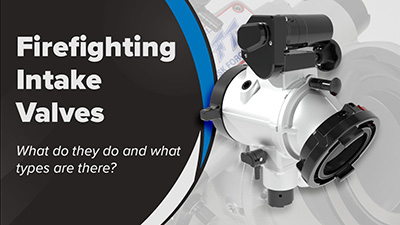What is an Intake Valve?
Have you ever wondered about the differences in types of intake valves? Ball intake valves (BIVs), piston intake valves, butterfly/wafer style intake valves – what does it all mean? What are the differences in how they work?
In this article we’re going to talk about the purpose of an intake valve and walk you through some of the most common types in the fire service. By the end, you should understand some of the similarities, differences, pros, and cons of each type.
What is an Intake Valve?
A firefighting intake valve allows you to control the flow of water into your pump from an outside source. That source could be a hydrant, drafting source, or any other common water source within your response district.
Without an intake valve, you would be limited to only using water that your apparatus can carry. Because of this, most pumpers use an intake valve to utilize added water supply.
There are four types of intake valves common in the fire service: ball intake valves, piston intake valves, butterfly/wafer style intake valves, and master intake valves. Let’s look at each and see how they work.
Types of Intake Valves:
Ball Intake Valves
Ball intake valves or BIVs have a ball valve or half-ball valve inside that controls the flow of water. These appliances get installed on the large intake connection of your pump panel. This makes it easy to access and means you can remove the appliance for service without taking your apparatus out of service like you would with an internal master intake valve!
Once installed, the valve can be controlled manually or via a remote control, depending on the options you choose. When opened, the ball valve moves to create a completely unobstructed water way for higher flow and lower friction loss. When closed, the ball valve or half-ball valve keeps water in the pump and out of the valve, minimizing corrosion and freezing concerns.
Most variations of the BIV allow the department to choose the operating handle position to avoid obstructions on the pump panel and/or fit behind a roll up door. Swiveling inlet elbows on these valves are also commonplace. Large diameter hose (LDH) can make a few twists and turns once the hose lay is charged. The swiveling inlet of the intake valve will move with the LDH and minimize kinks and twisting that cause flow restriction. That same elbow also allows the firefighter to rotate the position and make the LDH connection as easy as possible rather than fighting the hose line to connect to the pump’s inlet. It will also allow the department to position the LDH lay so it doesn’t completely block the roadway or avoid other challenges when positioning the firefighting trucks.
These valves are popular due to their ease of service but do require consideration of your pump panel size and layout to ensure a comfortable fit without obstructions.
Piston Intake Valves
The piston style intake valve is common in the fire service. As the name implies, the intake uses an internal piston to gate and/or open and close the valve to allow water to the intake of the pump.
This style of valve orients the piston to sit horizontally which means there is always some resting water inside the valve. This can accelerate corrosion or cause icing issues during freezing weather.
Like ball intake valves, the piston intake valve can be controlled manually or via remote control depending on the options you choose during order.
Butterfly/Wafer Style Intake Valves
Butterfly or wafer style intake valves use a quarter turn handle to control the water flow. When opened, the butterfly valve disk rotates 90 degrees, allowing water to pass by on each side of it. By design, this style of intake valve has an obstruction in the middle of your water flow. This can increase friction loss and turbulence.
Butterfly/wafer valves can be found in internal and external intake valve styles, making them common in the fire service.
Master Intake Valves
Master intake valves are built into your pump and may or may not use a butterfly style valve. These intake valves are provided by the pump manufacturer and are well-protected from outside damage.
Unlike external intake valve styles, master intake valves cannot be easily removed for service or replacement. If your master intake valve needs serviced, your entire apparatus must go out of service for the duration of the repair or replacement.
Which Intake Valve is Right for You?
You should choose an intake valve based on the needs of your department. A few things to consider include:
-
How often your crew drafts from a static water source
-
How often your weather drops below freezing where ice may be a concern
-
Your water quality and whether you ever draft from a saltwater source which may lead to corrosion
-
The layout and size of your pump panel, including whether it will be behind a roll up door
-
If you need or want remote control capabilities
-
The long-term ownership cost and warranty for the intake valve you are considering
These are only some of the things you should consider as you evaluate intake valves. Consulting with your local firefighting equipment dealer can also help you find the right solution for your needs.
Watch now: 3 Tips for Choosing the Right Intake Valve for You
